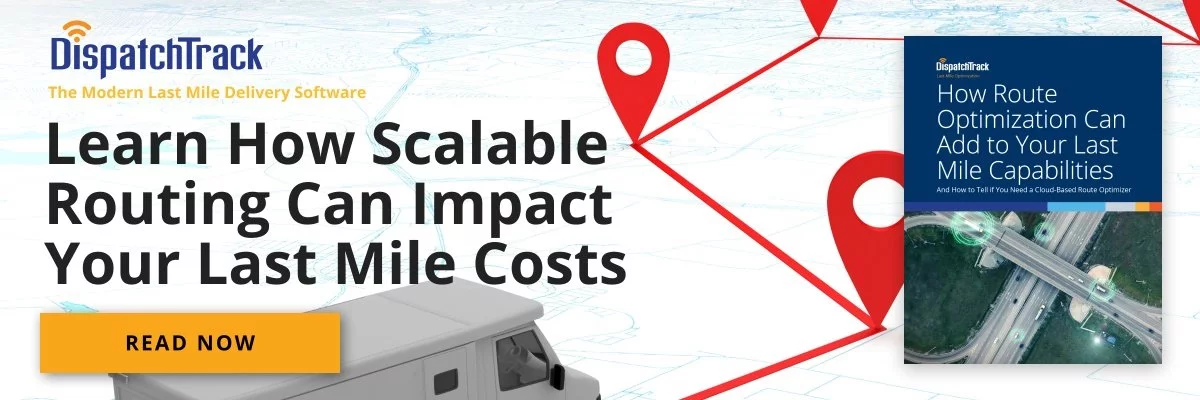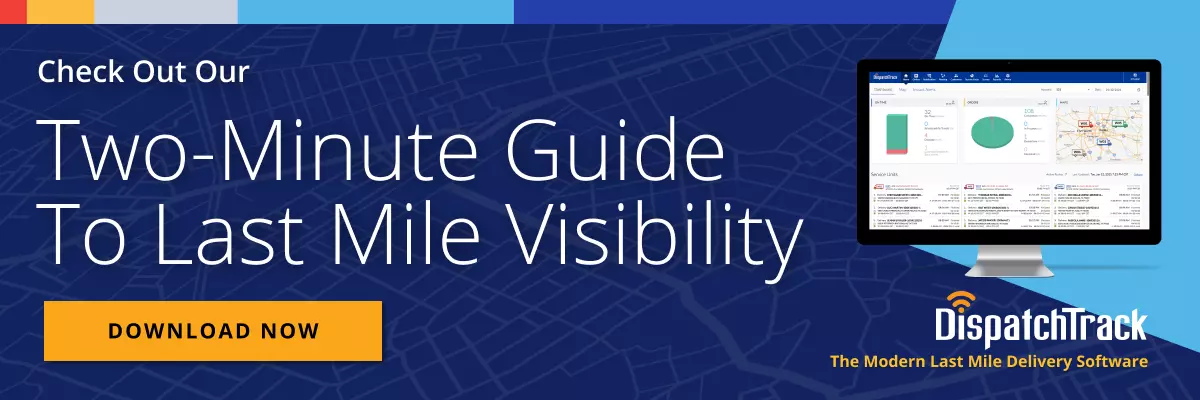The following is Part 4 in a series of posts about DispatchTrack’s point of view on the trends that will drive the logistics and logistics technology markets in 2022 and beyond. This week, we’ll be discussing the role that the middle mile plays in optimizing deliveries across the supply chain—and, by extension, in meeting heightened consumer demands. You can check out Part 1, Part 2, and Part 3, or you may also be interested in DispatchTrack CEO and co-founder Satish Natarajan’s Logistics Technology Wishlist for 2022.
We’ve all seen the statistics about the last mile: it’s consistently rated as the most expensive, most time consuming, and least efficient part of the supply chain. New technology has helped to power real strides in that department in recent years, but the fundamental truth remains the same: the last mile is the most difficult leg of the product’s journey to the end customer.

But what about the transportation logistics processes that happen before the last mile? Increasingly, those are getting complex as well. Because of the pressures that the e-commerce boom and the general air of volatility have exerted on transportation networks around the globe, FTL shipping is quickly losing ground to LTL in a lot of different supply chains. In other words, the middle mile is starting to look more and more like the last mile.
In the coming year, that fact is going to play a major part in shaping the way that shippers do business.
Is Middle Mile the New Last Mile?
On some level, LTL shipping has always had some fundamental similarities to last mile distribution. LTL typically requires partial loads getting dropped at a number of fulfillment centers, which means that concepts like multi-stop route planning already apply, and there is value to finding the most efficient route between drop off points. By the same token, on-time performance often matters—since the final leg of the distribution process can’t get underway until the necessary items have been received.
None of this is new. What is new is the fact that LTL is being utilized on a more regular basis—it’s actually becoming more common than FTL shipping in a lot of use cases, and it’s a lot more expensive. Simply put, this raises the stakes. If you optimize something that only happens once in a while, you may save money, but the ROI for your efforts might be dismal. When that thing starts to become commonplace, however, the potential for ROI skyrockets.
As LTL continues to become the norm in middle mile shipping, it’s going to become an obvious area for optimization. For anyone who has already put a lot of effort into optimizing the final mile, this process will probably look familiar.
How Middle Mile Optimization Impacts Logistics Costs
To really get into the impact of a changing approach to middle mile operations, we need to talk about technology. Up until you get to the last mile, you might be using a TMS or something similar to manage the movement of goods from Point A to Point B—and for predictable, repeatable processes, this is usually perfect. And when you need to compare rates between different modes, a TMS is precisely the right tool for the job. But when you start adding new levels of complexity and grappling with day-to-day changes in how you get product to your distribution centers, the game changes.
Now, instead of mode and carrier determining shipping cost, things like route efficiency and operational efficiency can become much more significant factors. Every area that can be optimized is also an area where waste can creep in, and it’s suddenly highly important to think about all the possible cost optimization opportunities here.
Of course, as we’ve seen in the other trends so far: cost isn’t everything. Sometimes the most important thing is to get the product cycled through your supply chain as quickly as possible. But the same principle applies: you need to start treating the middle mile more like the last mile.
What Can Last Mile Optimization Tell Us About the Middle Mile?
In 2022, we expect folks across a number of industries to start treating the middle mile more like the last mile. But what does that mean exactly?
At a high level, there are a few things about the way modern businesses handle the last mile that could be transferable to middle mile operations:
- Route optimization: First thing off the bat, the route optimization techniques that businesses use to reduce inefficiency in the last mile begin to apply as soon as your middle mile operations involve more than a few stops. As with the last mile, you need to be able to find a sequence of stops that finds the minimum travel time while accounting for a number of different parameters (e.g. time window requirements for particular stops).
- ETA calculation: Once your routing looks more like last mile routing, you wind up with the same thorny problem that has plagued last mile operators for years: how to determine accurate ETAs. Here, it’s useful to take a page from the playbook of businesses who utilize AI and machine learning to estimate arrival times.
- Real-time tracking and visibility: Again, the more complex something is, the more important it is to be able to get the right information—quickly. Once you add additional complexity to middle mile operations, you’ll want a way to track what’s happening on every delivery run at a granular level in real time. Once you’ve captured the information, you need to be able to easily visualize what’s happening on the delivery run from a single screen. In this way, you can spot potential issues more quickly and work proactively to address them. This ultimately paves the way to improved efficiency.
- Constant communication: There are obviously differences between customer needs and expectations in last mile delivery logistics vs. middle mile logistics, but a key part of the visibility and transparency we talked about above is the ability to share information in real time between stakeholders. When you can make this happen across the middle mile, you can keep everyone in the loop and ensure that the needs of individual distribution centers get prioritized appropriately. This (plus real-time visibility) can have the added benefit of ensuring a smoother handoff between middle mile and final mile operations.
At the end of the day, the middle mile is a distinct entity with its own set of challenges—but as consumer expectations skyrocket and LTL continues to be more common and more expensive, it’s going to become much more common to see people treating the middle mile more like the last mile. While this trend isn’t likely to reach its apex in the coming year, it’s something to keep an eye on—especially for businesses looking out for ways to gain a competitive advantage.

